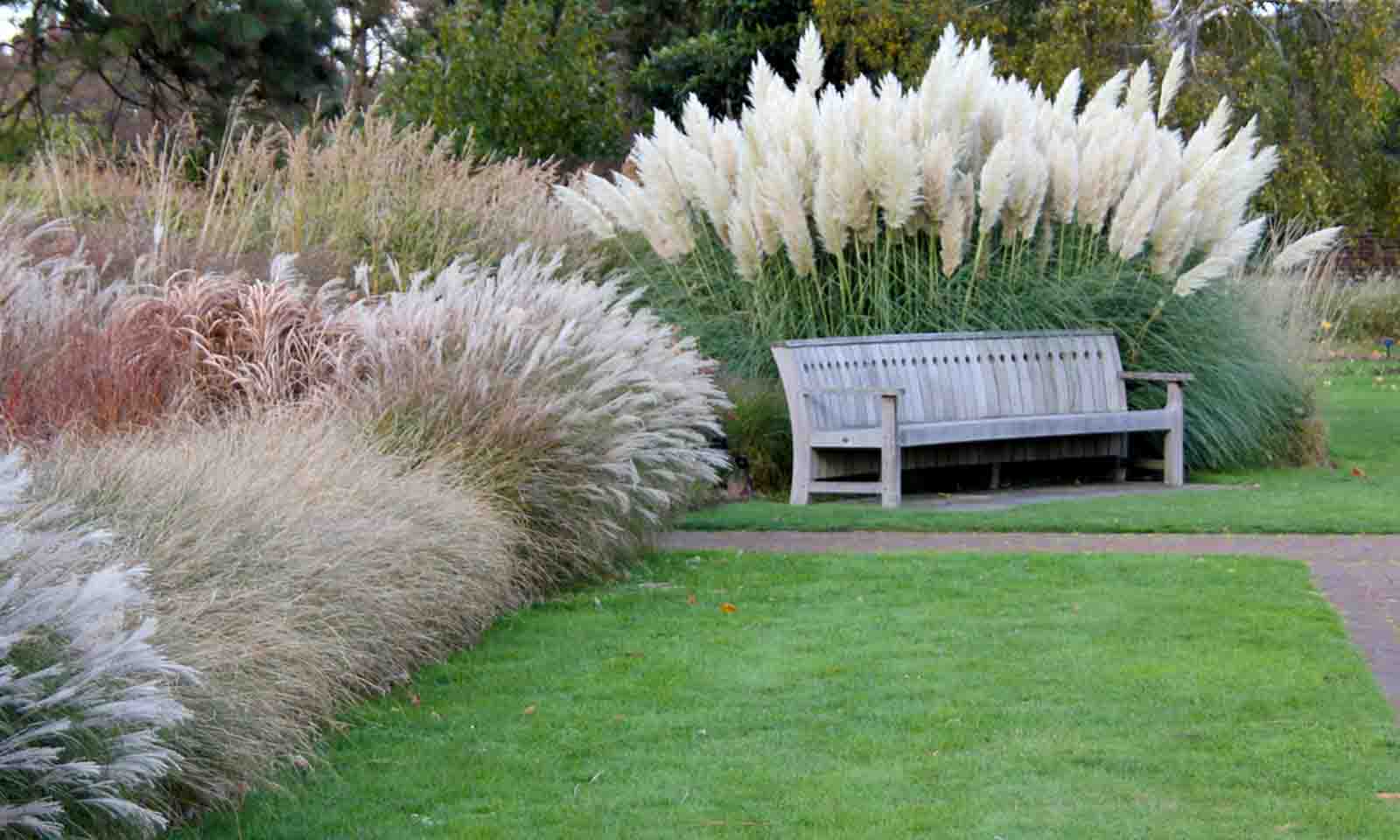Alright, let’s talk about cortaderia – you might know it as pampas grass. It’s that big, feathery stuff you see waving around, and it’s got quite a story!
Cortaderia is a genus of grasses, and the most famous member is probably Cortaderia selloana. It’s native to South America, those wide-open pampas grasslands in Argentina and Brazil, hence the name. But it’s a bit of a traveler and has popped up in lots of other places around the world, sometimes causing a bit of trouble.
What Does Cortaderia Look Like?
You can’t really miss it. These are big, bold plants. They form huge clumps of long, narrow, and often quite sharp leaves that can reach a good few feet in height. Then come the flower plumes – those are the showstoppers. They can be silvery-white, sometimes a bit pinkish or purplish, and they stand tall above the foliage, like giant fluffy feathers. These plumes can be seriously impressive, sometimes reaching a metre or more in length.

Why All the Fuss About Pampas Grass?
For a lot of people, pampas grass is beautiful. Those elegant plumes can add a real touch of drama to gardens and landscapes. Florists love them for arrangements, and they’ve even been a bit of a fashion statement at times. You might see them used in decorations or even as a backdrop in photos.
However, there’s a bit of a downside. Because it’s not native to many of the places it now grows, it can become invasive. This means it can spread really quickly and outcompete the local plants. It can form dense thickets that take over habitats and reduce biodiversity. The sharp leaves can also be a bit of a hazard.
How Does It Spread So Easily?

Those beautiful plumes are actually packed with thousands of tiny seeds. The wind picks them up and carries them far and wide. Because each plant can produce so many seeds, it doesn’t take long for it to colonize new areas. It’s also pretty tough and can grow in a variety of conditions, which makes it even more successful at spreading.
Where Can You Find It?
Originally from South America, you can now find cortaderia in many parts of the world, including parts of North America, Europe, Australia, and New Zealand. It often pops up in coastal areas, disturbed sites, and even along roadsides. In some regions, there are active efforts to control its spread.
Different Kinds of Cortaderia
While Cortaderia selloana is the most well-known, there are other species in the Cortaderia genus. Some are smaller, and they might have slightly different features. However, when people talk about pampas grass becoming invasive, they’re usually referring to Cortaderia selloana.
What Can Be Done About Invasive Pampas Grass?
Controlling pampas grass can be a real challenge once it gets established. Because it produces so many seeds and has tough roots, simply pulling it out might not be enough. Often, a combination of methods is needed, such as cutting it back, digging out the roots, and sometimes even using herbicides. Prevention is key, which is why in some areas, it’s advised not to plant it in the first place.
So, there you have it – a bit of a deeper dive into the world of cortaderia, the often-stunning but sometimes troublesome pampas grass. It’s a plant with a fascinating journey from the South American plains to many corners of the globe, bringing both beauty and ecological challenges along the way.
Conclusion
Cortaderia, or pampas grass, stands as a striking example of nature’s beauty with a complex ecological footprint. Its impressive plumes have captured human admiration worldwide, leading to its introduction and cultivation in numerous regions far from its South American origins. However, this widespread adoption has also revealed a less desirable trait: its potential to become an invasive species, outcompeting native flora and altering ecosystems. Understanding the characteristics of cortaderia, its dispersal mechanisms, and the challenges associated with its control is crucial for managing its impact and preserving biodiversity in vulnerable environments. While its aesthetic appeal is undeniable, a responsible approach necessitates careful consideration of its potential ecological consequences.
Frequently Asked Questions About Cortaderia
Is all pampas grass considered invasive?
While Cortaderia selloana is the species most often associated with invasiveness, not all members of the Cortaderia genus are equally problematic. However, due to the high seed production and adaptability of C. selloana, it poses the greatest risk in many non-native environments.
How can I tell if I have pampas grass in my garden?
Pampas grass is quite distinctive. Look for large clumps of sharp, narrow leaves and tall, feathery plumes that are typically silvery-white. The overall size of the plant is also a key indicator, as mature plants can be several feet tall and wide.
What are the negative impacts of invasive pampas grass?
Invasive pampas grass can outcompete native plants for resources like sunlight, water, and nutrients, leading to a reduction in local biodiversity. Its dense growth can also alter habitats and increase the risk of fire in some ecosystems.
Are there any native alternatives to pampas grass for landscaping?
Yes, depending on your location, there are many beautiful native grasses and other plants that can provide similar texture and visual interest without the risk of invasiveness. Local horticultural societies or native plant nurseries can offer excellent suggestions for your region.
What is the best way to get rid of pampas grass if it’s growing where it shouldn’t?
Control methods vary depending on the size and maturity of the plant. Young plants might be dug up, ensuring you remove the entire root system. For larger, established plants, cutting back the foliage followed by digging out the roots or applying appropriate herbicides may be necessary. It’s often a persistent task, and repeated efforts might be required.
